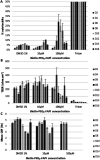Inhibitor-conjugated harmonic nanoparticles targeting fibroblast activation protein
- PMID: 35527932
- PMCID: PMC9072645
- DOI: 10.1039/c9ra05299b
Inhibitor-conjugated harmonic nanoparticles targeting fibroblast activation protein
Abstract
The recent progress in the engineering of nanosized inorganic materials presenting tailored physical properties and reactive surface for post-functionalization has opened promising avenues for the use of nanoparticles (NPs) in diagnosis and therapeutic intervention. Surface decoration of metal oxide NPs with ligands modulating circulation time, cellular uptake, affinity and extravasation through active targeting led to efficient cancer specific bioimaging probes. The most relevant cancer biomarkers studied so far include surface and transmembrane cancer cell receptors. More recently, tumor microenvironments and more specifically the fibroblastic element of the tumor stroma have emerged as a valuable target for diagnosis and treatment of several types of cancers. In this study, a low molecular weight ligand targeting fibroblast activation protein α (FAP), which is specifically expressed by activated fibroblasts of the tumor stroma, was synthesized. This ligand demonstrated nanomolar inhibition of FAP with high selectivity with respect to prolyl oligopeptidase (PREP) and dipeptidyl peptidase (DPP) IV, as well as good biocompatibility toward a human lung tissue model. Bismuth ferrite (BFO) harmonic nanoparticles (HNPs) conjugated to this ligand showed target-specific association to FAP as demonstrated by reverse ELISA-type assay using Human Fibroblast Activation Protein alpha/FAP Alexa Fluor® 594-conjugated Antibody and multiphoton multispectral microscopy experiments. These functionalized HNPs may provide new nanocarriers to explore the role of FAP in tumorigenesis and to target the fibroblastic component of the tumor microenvironment.
This journal is © The Royal Society of Chemistry.
Conflict of interest statement
There are no conflicts to declare.
Figures





Similar articles
-
Selective Inhibitors of Fibroblast Activation Protein (FAP) with a (4-Quinolinoyl)-glycyl-2-cyanopyrrolidine Scaffold.ACS Med Chem Lett. 2013 Mar 18;4(5):491-6. doi: 10.1021/ml300410d. eCollection 2013 May 9. ACS Med Chem Lett. 2013. PMID: 24900696 Free PMC article.
-
Targeting fibroblast activation protein (FAP): next generation PET radiotracers using squaramide coupled bifunctional DOTA and DATA5m chelators.EJNMMI Radiopharm Chem. 2020 Jul 29;5(1):19. doi: 10.1186/s41181-020-00102-z. EJNMMI Radiopharm Chem. 2020. PMID: 32728930 Free PMC article.
-
Targeting inhibition of fibroblast activation protein-α and prolyl oligopeptidase activities on cells common to metastatic tumor microenvironments.Neoplasia. 2013 Apr;15(4):348-58. doi: 10.1593/neo.121850. Neoplasia. 2013. PMID: 23555181 Free PMC article.
-
Molecular recognition of fibroblast activation protein for diagnostic and therapeutic applications.Biochim Biophys Acta Proteins Proteom. 2020 Jul;1868(7):140409. doi: 10.1016/j.bbapap.2020.140409. Epub 2020 Apr 6. Biochim Biophys Acta Proteins Proteom. 2020. PMID: 32171757 Review.
-
Rationale behind targeting fibroblast activation protein-expressing carcinoma-associated fibroblasts as a novel chemotherapeutic strategy.Mol Cancer Ther. 2012 Feb;11(2):257-66. doi: 10.1158/1535-7163.MCT-11-0340. Mol Cancer Ther. 2012. PMID: 22323494 Free PMC article. Review.
Cited by
-
The Prognostic and therapeutic value and clinical implications of fibroblast activation protein-α as a novel biomarker in colorectal cancer.Cell Commun Signal. 2023 Jun 14;21(1):139. doi: 10.1186/s12964-023-01151-y. Cell Commun Signal. 2023. PMID: 37316886 Free PMC article. Review.
-
Air-liquid interface cultures of the healthy and diseased human respiratory tract: promises, challenges and future directions.Adv Nanobiomed Res. 2021 May 6;1(6):2000111. doi: 10.1002/anbr.202000111. eCollection 2021 Jun. Adv Nanobiomed Res. 2021. PMID: 34345878 Free PMC article.
-
FAP Targeting of Photosensitizer-Loaded Polymersomes for Increased Light-Activated Cell Killing.Biomacromolecules. 2024 Feb 12;25(2):754-766. doi: 10.1021/acs.biomac.3c00943. Epub 2024 Jan 24. Biomacromolecules. 2024. PMID: 38267014 Free PMC article.
References
-
- Argyo C. Weiss V. Bräuchle C. Bein T. Chem. Mater. 2014;26:435. doi: 10.1021/cm402592t. - DOI
LinkOut - more resources
Full Text Sources
Other Literature Sources
Miscellaneous

